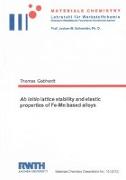- Start
- Ab initio lattice stability and elastic properties of Fe-Mn based alloys
Ab initio lattice stability and elastic properties of Fe-Mn based alloys
Angebote / Angebote:
Fe-Mn based alloys exhibit fascinating properties for a wide range of applications. Fe-Mn alloys can be seen as prototypes for high-Mn steels, featuring high strength and exceptional plasticity due to various metal-physical deformation mechanisms under mechanical load, providing therefore great potential for structural components in automotive engineering. The stacking fault energy (SFE) of the face-centered-cubic (fcc) phase, strongly affected by the chemical composition, governs the deformation behavior and hence the mechanical properties.
In a first part of this thesis, the influence of the magnetic state on the lattice stability of fcc vs. hcp Fe-Mn random alloys with and without additions of Al and Si was studied using ab initio calculations. The ab initio results are consistent with thermodynamic calculations, obtained with Calphad. With room temperature magnetic configurations, the cross-over between Ehcp and Efcc of binary Fe-Mn alloys is in the expected Mn range and the increase of SFE below the Néel temperature due to additions of Mn is well displayed. The addition of Al strongly stabilizes the fcc lattice below the fcc Néel temperature, which is consistent with an increase in SFE, whereas adding Si yields a stabilization of the hcp lattice and is hence expected to decrease the SFE. For the paramagnetic (PM) configuration, the hcp lattice is stable for all regarded compositions, at which both Al and Si additions decrease the lattice stability of hcp and hence may increase the SFE. Based on a comparison with experimental results, the qualitative trends of the influence of the alloying elements Al and Si on the SFE are well displayed using the proposed firstprinciples description of the lattice stability of hcp and fcc Fe-Mn random alloys. These results are therefore of relevance for understanding and describing the deformation mechanisms and hence the mechanical properties of these random alloys.
In a second part, the influence of the chemical composition and magnetic effects on the elastic properties of fcc Fe-Mn based alloys was investigated using a combined theoretical and experimental research strategy. In a first step, binary Fe-Mn thin films with a graded chemical composition were synthesized. Nanoindentation experiments were carried out to investigate the elastic properties as a function of the Mn content. As the Mn content increases from ~ 23 to ~ 39 at.-%, the average bulk modulus varies from 143 to 105 GPa. Ab initio calculations served to evaluate magnetic effects on the elastic properties. The magnetic state description with disordered local moments yields the best agreement with the experimental results, whereas with nonmagnetic and antiferromagnetic (AFM) configurations the bulk modulus is overestimated. The strong impact of the magnetic configuration may be understood based on the differences in the chemical bonding and the magnetovolume effect. It is suggested that due to minute energy differences of competing AFM configurations, a mixture of these with a "notional magnetic disorder" is present, which can in fact be well described by the disordered local moments model. Furthermore, the influence of Al and Si additions on the elastic properties of fcc Fe-Mn random alloys with Fe/Mn ratios of 4.00 and 2.33 was evaluated using ab initio calculations. When Al is added up to 8 at.-%, the shearing elastic constants (C11-C12)/2 and C44 decrease resulting in a drop of ~ 20 % in shear and ~ 19 % in Young's modulus. In fcc Fe-Mn-Si alloys, the trends in the elastic constants are similar, but less drastic, with a ~ 7 % shear and ~ 6 % Young's modulus decrease when Si is added up to 8 at.-%. The Fe/Mn ratio exhibits a minor influence on the shear and Young's modulus values at constant Al and Si contents. To assess the ab initio data, Fe-Mn-Al and Fe-Mn-Si thin films with an fcc structure were combinatorially synthesized and the elastic properties were measured using nanoindentation. For both systems the measured and calculated lattice parameters are in good agreement. Although the measured Young's modulus data scatter significantly due to large surface roughness, they are in good agreement with the predictions. For the Fe-Mn-Al system the calculations generally underestimate the experimental data by ~ 15 %. With respect to the Fe-Mn-Si system, the calculation data are in general by ~ 10 % lower than the experimentally determined values, indicating that the effect of Si and Al additions on the elastic properties of Fe-Mn alloys can be predicted based on ab initio data. The presented results are of relevance for multicomponent alloy design.
Libri-Titel folgt in ca. 2 Arbeitstagen

